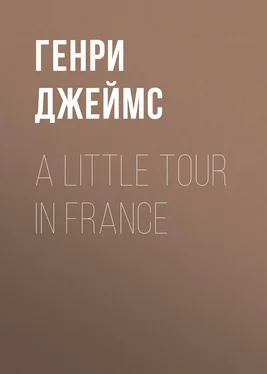Генри Джеймс - A Little Tour in France
Здесь есть возможность читать онлайн «Генри Джеймс - A Little Tour in France» — ознакомительный отрывок электронной книги совершенно бесплатно, а после прочтения отрывка купить полную версию. В некоторых случаях можно слушать аудио, скачать через торрент в формате fb2 и присутствует краткое содержание. Жанр: Путешествия и география, foreign_antique, foreign_prose, на английском языке. Описание произведения, (предисловие) а так же отзывы посетителей доступны на портале библиотеки ЛибКат.
- Название:A Little Tour in France
- Автор:
- Жанр:
- Год:неизвестен
- ISBN:нет данных
- Рейтинг книги:4 / 5. Голосов: 1
-
Избранное:Добавить в избранное
- Отзывы:
-
Ваша оценка:
- 80
- 1
- 2
- 3
- 4
- 5
A Little Tour in France: краткое содержание, описание и аннотация
Предлагаем к чтению аннотацию, описание, краткое содержание или предисловие (зависит от того, что написал сам автор книги «A Little Tour in France»). Если вы не нашли необходимую информацию о книге — напишите в комментариях, мы постараемся отыскать её.
A Little Tour in France — читать онлайн ознакомительный отрывок
Ниже представлен текст книги, разбитый по страницам. Система сохранения места последней прочитанной страницы, позволяет с удобством читать онлайн бесплатно книгу «A Little Tour in France», без необходимости каждый раз заново искать на чём Вы остановились. Поставьте закладку, и сможете в любой момент перейти на страницу, на которой закончили чтение.
Интервал:
Закладка:
The immediate successors of Francis I. continued to visit, Chambord; but it was neglected by Henry IV., and was never afterwards a favorite residence of any French king. Louis XIV. appeared there on several occasions, and the apparition was characteristically brilliant; but Chambord could not long detain a monarch who had gone to the expense of creating a Versailles ten miles from Paris. With Versailles, Fon- tainebleau, Saint-Germain, and Saint-Cloud within easy reach of their capital, the later French sovereigns had little reason to take the air in the dreariest province of their kingdom. Chambord therefore suffered from royal indifference, though in the last century a use was found for its deserted halls. In 1725 it was oc- cupied by the luckless Stanislaus Leszczynski, who spent the greater part of his life in being elected King of Poland and being ousted from his throne, and who, at this time a refugee in France, had found a compensation for some of his misfortunes in marry- ing his daughter to Louis XV. He lived eight years at Chambord, and filled up the moats of the castle. In 1748 it found an illustrious tenant in the person of Maurice de Saxe, the victor of Fontenoy, who, how- ever, two years after he had taken possession of it, terminated a life which would have been longer had he been less determined to make it agreeable. The Revolution, of course, was not kind to Chambord. It despoiled it in so far as possible of every vestige of its royal origin, and swept like a whirlwind through apartments to which upwards of two centuries had contributed a treasure of decoration and furniture. In that wild blast these precious things were destroyed or forever scattered. In 1791 an odd proposal was made to the French Government by a company of English Quakers who had conceived the bold idea of establishing in the palace a manufacture of some peaceful commodity not to-day recorded. Napoleon allotted Chambord, as a "dotation," to one of his marshals, Berthier, for whose benefit it was converted, in Napoleonic fashion, into the so-called principality of Wagram. By the Princess of Wagram, the marshal's widow, it was, after the Restoration, sold to the trustees of a national subscription which had been established for the purpose of presenting it to the in- fant Duke of Bordeaux, then prospective King of France. The presentation was duly made; but the Comte de Chambord, who had changed his title in recognition of the gift, was despoiled of his property by the Government of Louis Philippe. He appealed for redress to the tribunals of his country; and the consequence of his appeal was an interminable litiga- tion, by which, however, finally, after the lapse of twenty-five years, he was established in his rights. In 1871 he paid his first visit to the domain which had been offered him half a century before, a term of which he had spent forty years in exile. It was from Chambord that he dated his famous letter of the 5th of July of that year, – the letter, directed to his so- called subjects, in which he waves aloft the white flag of the Bourbons. This amazing epistle, which is virtually an invitation to the French people to re- pudiate, as their national ensign, that immortal tricolor, the flag of the Revolution and the Empire, under which they have, won the glory which of all glories has hitherto been dearest to them, and which is as- sociated with the most romantic, the most heroic, the epic, the consolatory, period of their history, – this luckless manifesto, I say, appears to give the measure of the political wisdom of the excellent Henry V. It is the most factitious proposal ever addressed to an eminently ironical nation.
On the whole, Chambord makes a great impression; and the hour I was, there, while the yellow afternoon light slanted upon the September woods, there was a dignity in its desolation. It spoke, with a muffled but audible voice, of the vanished monarchy, which had been so strong, so splendid, but to-day has be- come a sort of fantastic vision, like the cupolas and chimneys that rose before me. I thought, while I lingered there, of all the fine things it takes to make up such a monarchy; and how one of them is a su- perfluity of mouldering, empty, palaces. Chambord is touching, – that is the best word for it; and if the hopes of another restoration are in the follies of the Republic, a little reflection on that eloquence of ruin ought to put the Republic on its guard. A sentimental tourist may venture to remark that in the presence of several chateaux which appeal in this mystical manner to the retrospective imagination, it cannot afford to be foolish. I thought of all this as I drove back to Blois by the way of the Chateau de Cheverny. The road took us out of the park of Chambord, but through a region of flat woodland, where the trees were not mighty, and again into the prosy plain of the Sologne, – a thankless soil, all of it, I believe, but lately much amended by the magic of cheerful French industry and thrift. The light had already begun to fade, and my drive reminded me of a passage in some rural novel of Madame Sand. I passed a couple of timber and plaster churches, which looked very old, black, and crooked, and had lumpish wooden porches and galleries encircling the base. By the time I reached Cheverny, the clear twilight had approached. It was late to ask to be allowed to visit an inhabited house; but it was the hour at which I like best to visit almost anything. My coachman drew up before a gateway, in a high wall, which opened upon a short avenue, along which I took my way on foot; the coachmen in those parts being, for reasons best known to them- selves, mortally averse to driving up to a house. I answered the challenge of a very tidy little portress, who sat, in company with a couple of children, en- joying the evening air in, front of her lodge, and who told me to walk a little further and turn to the right. I obeyed her to the letter, and my turn brought me into sight of a house as charming as an old manor in a fairy tale. I had but a rapid and partial view of Cheverny; but that view was a glimpse of perfection. A light, sweet mansion stood looking over a wide green lawn, over banks of flowers and groups of trees. It had a striking character of elegance, produced partly by a series of Renaissance busts let into circular niches in the facade. The place looked so private, so reserved, that it seemed an act of violence to ring, a stranger and foreigner, at the graceful door. But if I had not rung I should be unable to express – as it is such a pleasure to do – my sense of the exceeding courtesy with which this admirable house is shown. It was near the dinner-hour, – the most sacred hour of the day; but I was freely conducted into the inhabited apartments. They are extremely beautiful. What I chiefly remember is the charming staircase of white embroidered stone, and the great salle des gardes and chambre a coucher du roi on the second floor. Che- verny, built in 1634, is of a much later date than the other royal residences of this part of France; it be- longs to the end of the Renaissance, and has a touch of the rococo. The guard-room is a superb apartment; and as it contains little save its magnificent ceiling and fireplace and certain dim tapestries on its walls, you the more easily take the measure of its noble proportions. The servant opened the shutters of a single window, and the last rays of the twilight slanted into the rich brown gloom. It was in the same pic- turesque fashion that I saw the bedroom (adjoining) of Henry IV., where a legendary-looking bed, draped in folds long unaltered, defined itself in the haunted dusk. Cheverny remains to me a very charming, a partly mysterious vision. I drove back to Blois in the dark, some nine miles, through the forest of Russy, which belongs to the State, and which, though con- sisting apparently of small timber, looked under the stars sufficiently vast and primeval. There was a damp autumnal smell and the occasional sound of a stirring thing; and as I moved through the evening air I thought of Francis I. and Henry IV.
Читать дальшеИнтервал:
Закладка:
Похожие книги на «A Little Tour in France»
Представляем Вашему вниманию похожие книги на «A Little Tour in France» списком для выбора. Мы отобрали схожую по названию и смыслу литературу в надежде предоставить читателям больше вариантов отыскать новые, интересные, ещё непрочитанные произведения.
Обсуждение, отзывы о книге «A Little Tour in France» и просто собственные мнения читателей. Оставьте ваши комментарии, напишите, что Вы думаете о произведении, его смысле или главных героях. Укажите что конкретно понравилось, а что нет, и почему Вы так считаете.












